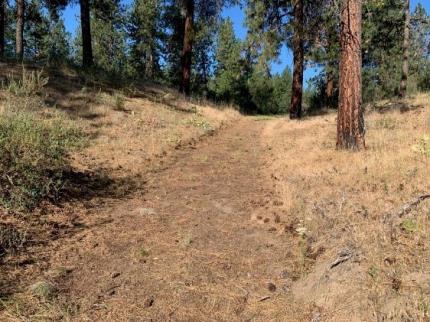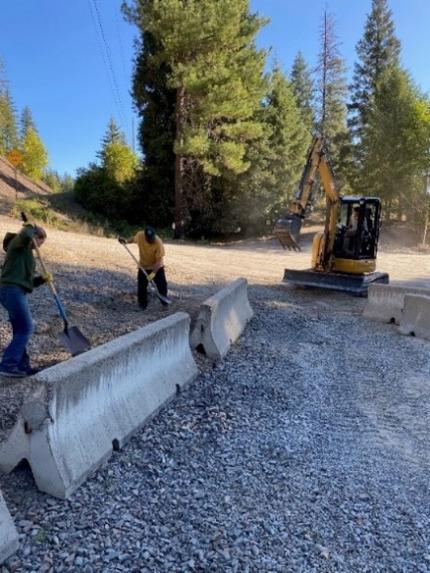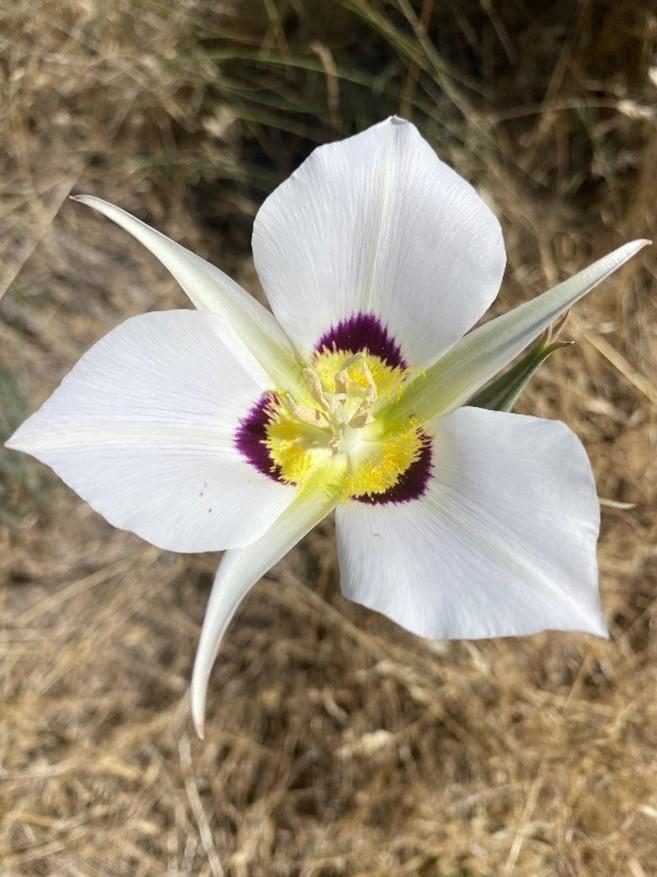Managing Wildlife Populations
Tucannon Bighorn Sheep Herd: Wildlife Area Manager Dingman located the Tucannon bighorn sheep herd this week and found all 12 sheep, including 3 lambs, that make up the majority of the herd.

Chronic Wasting Disease: Dingman sampled a roadkill white-tailed doe along Patit Road on one of her morning commutes this week. Dingman contacted the new owners of the Last Resort Campground regarding collecting Chronic Wasting Disease (CWD) samples there again this fall. They are on-board to allow us to collect samples from harvested deer in the cooler, as hunters allow, and to set up a check station during general deer season.
Chronic Wasting Disease Operations: Natural Resource Technician Heitstuman checked local pits for CWD Samples. Local Department of Transportation (DOT) employees have noticed a drop in numbers of road kills. Heitstuman discussed DOT participation and tag supply with District Biologist Wik.
Chronic Wasting Disease Sample: Natural Resource Technician Harris collected a CWD sample from a roadkill deer in GMU 117. Natural Resource Technician Janowski collected a CWD sample from a deer in GMU 121. The deer had been struck by a vehicle and survived but was euthanized as a result of the injuries.
Providing Recreation Opportunities
Trail Clean-up: Wildlife Area Assistant Manager Palmer and Natural Resources Technician Zueger spent the morning of July 20 clearing pinecones off the hiking trail along the Columbia River, between Sherman Creek Headquarters and Haag Cove to the south. They used a motorized “flapper-wheel” attachment on a weed whacker pole, that pushes the cones off the route of travel.



Access Program: Acting Private Lands Biologist Nizer corresponded with the Turnbull Wildlife Refuge about the upcoming contract for 1,800 acres on the refuge that would provide turkey hunting in the Hunt by Reservation program. The contract is in the hands of the United States Fish and Wildlife Service (USFWS) and should be ready for signatures in the coming weeks.
Cooperative Road Management Agreement: Natural Resource Technician Harris visited several timber parcels enrolled in the Cooperative Road Management Agreement (CRMA) program and checked for proper signage and recreation activity.
Recreation Access Closure: Natural Resource Technician Janowski coordinated with Communications Specialist Lehman to relay information to other WDFW staff members regarding private and industrial timber access closures. Several timber companies who typically allow public access had decided to close lands due to the fire danger. A timber company in Stevens County is participating in this closure.
Grande Ronde River Access Sites: Heimgartner and Nielsen graveled one of the driveways at the Faha access site. They hauled two, three dump trailer loads of rock on the road and smoothed it with their John Deere tractor and land plane.

Horseshoe Lake Jersey Barriers: Earlier this year, someone hit the concrete jersey barriers at the Horseshoe Lake access area with a vehicle. One barrier was dislodged from its position, another was dragged into the driveway that leads to the parking area, creating a hazard for visitors’ vehicles. This week, Sherman Creek Wildlife Area and water access area staff members coordinated to remedy the situation using a mini-excavator, truck, chains, and hand tools. A line of jersey barriers separated the county road from the access area parking lot, but they were originally set haphazardly with large gaps in between. Rather than just moving and turning the dislodged barriers upright, the four employees reinstalled them correctly. Wildlife Area Assistant Manager Palmer used the mini-excavator to move the barriers out of the way so the team could prepare the ground. As Palmer pushed gravel out of the way, Natural Resource Technicians Brant and Zueger used hand shovels to flatten the site. Once the prep work was done, the dislodged barriers were righted and installed properly. With a deft touch, Palmer got all the barriers set back in place, bumped up against each other and straight. This reduced the length the row that stuck out too close to the entrance of the access area by the length of one barrier. The shorter row should help prevent anyone from running into them in the future as they turn into the parking area. Having them linked together will reduce the chances of damage from barriers being pushed into parked cars or being left in the middle of the driveway if they are hit again. This repair is a great example of different work groups joining to get a big job done.


Providing Conflict Prevention and Education
Bear Trap: Wildlife Conflict Specialist Kolb picked up a new bear trap and capture tarp from the Wenatchee office.

Conserving Natural Landscapes
Asotin Creek Wildlife Area Spalding Catchfly Surveys: Woodall and the University of Idaho interns recently completed eight Spalding catchfly surveys for the year. There are two more to go, that they can finish next week.



Reardan Audubon Access Work: Access Manager Dziekan and Natural Resource Technician Brant painted the parking areas on the access sites.


Habitat Site Evaluation: Acting Private Lands Biologist Nizer and Natural Resource Technician Rumiser checked a 20-acre site that was seeded in spring as a cover crop to see how it looked. The landowner recently mowed it, but everything looks like it grew at a good rate. Site will be planted again in the fall for a pollinator crop.
Guzzler Repair: Private Lands Biologist Hadley worked with members from the Richland Rod and Gun Club to rebuild a wildlife watering facility (guzzler) roof and posts.

Cultural Review: Private Lands Biologist Hadley worked with WDFW Landscape Conservation Section Manager Gorrell as well as the Walla Walla Conservation District habitat planner regarding obtaining Cultural Reviews of upcoming habitat plantings projects.
Sourcing Seed and Plants: Natural Resource Technician Heitstuman conducted a field inspection on the Smoothing Iron Wildlife Area to help consider options for field food plots to support deer and elk through the winter as well as to try to keep the elk off surrounding private lands.
4-O Ranch Wildlife Area Grass Planting: Dice looked at orchard grass seeded on 53 acres on the 4-O Ranch Wildlife Area on Monday. The grass is looking good. Unfortunately, the weeds are thriving as well, and the field needs mowed as soon as possible. We are planning on moving a tractor along with a 15-foot mower from Joseph Creek to the 4-O Wildlife Area soon to mow the fields.


State Lands Restoration - Little Walla Walla River Restoration Project: Wildlife Area Manager Dingman started working on the United States Army Corps of Engineers (USACOE) Nationwide Permit application to obtain the necessary permits to complete the habitat restoration project on the Swegle Unit of the W. T. Wooten Wildlife Area. She also started working on the Cultural Resources desktop review request.
Providing Education and Outreach
Bear Airbnb Pamphlet: Wildlife Conflict Specialist McCarty began discussions of a guidance pamphlet of leaflet to provide Bear Aware information to Airbnb tenants in high tourism areas. This pamphlet can be provided by the property manager or owner in the welcome packet at each Airbnb location.
Wolf Presentation: Wildlife Conflict Supervisor McCanna and Wolf Biologist Roussin did a public PowerPoint presentation in Greenbluff. Biologists Lowe and Brinkman attended the presentation. The informal program provided information on the ecology and management of wolves in Washington to folks living in the area of the new Mt Spokane wolf pack. Around 80 people attended, and the information was well received.

Conducting Business Operations and Policy
Employee Evaluations: Private Lands Supervisor Earl worked on the Region 1 private lands team evaluations this week. Earl also travelled to meet with Biologist Baarstad to complete his evaluation.
Regional Meeting: Private Lands Biologist Hadley attended the Service and Regional Awards Meeting held at the Region 1 office with updates from directors and program breakout meetings.
